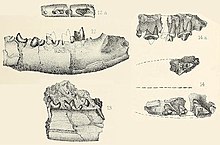Sinopidae
This article possibly contains original research. (November 2023) |
| Sinopidae Temporal range: Early to Middle Eocene
| |
|---|---|

| |
| Skeleton of Sinopa major | |

| |
| lower jaw of Prototomus secundarius | |
| Scientific classification | |
| Domain: | Eukaryota |
| Kingdom: | Animalia |
| Phylum: | Chordata |
| Class: | Mammalia |
| Order: | †Hyaenodonta |
| Family: | †Sinopidae Solé, 2013[1] |
| Type genus | |
| †Sinopa Leidy, 1871
| |
| Genera | |
| |
| Synonyms | |
Sinopidae ("swift foxes")[3] is an extinct family of predatory placental mammals from extinct order Hyaenodonta. Fossil remains of these mammals are known from early to middle Eocene deposits in North America, Europe and Asia.[5][6][7][8]
Classification and phylogeny[edit]
Taxonomy[edit]
- Family: †Sinopidae (Solé, 2013)
- Genus: †Acarictis (Gingerich & Deutsch, 1989)
- †Acarictis ryani (Gingerich & Deutsch, 1989)
- Genus: †Prototomus (Cope, 1874)
- †Prototomus deimos (Gingerich & Deutsch, 1989)
- †Prototomus girardoti (Smith & Smith, 2001)
- †Prototomus martis (Gingerich & Deutsch, 1989)
- †Prototomus minimus (Smith & Smith, 2001)
- †Prototomus phobos (Gingerich & Deutsch, 1989)
- †Prototomus robustus (Matthew & Granger 1915)
- †Prototomus secundarius (Cope, 1875)
- †Prototomus viverrinus (Cope, 1874)
- Genus: †Sinopa (Leidy, 1871)
- †Sinopa jilinia (Morlo, 2014)
- †Sinopa lania (Matthew, 1909)
- †Sinopa longipes (Peterson, 1919)
- †Sinopa major (Wortman, 1902)
- †Sinopa minor (Wortman, 1902)
- †Sinopa piercei (Bown, 1982)
- †Sinopa pungens (Cope, 1872)
- †Sinopa rapax (Leidy, 1871)
- Genus: †Acarictis (Gingerich & Deutsch, 1989)
References[edit]
- ^ Floréal Solé (2013). "New proviverrine genus from the Early Eocene of Europe and the first phylogeny of Late Palaeocene–Middle Eocene hyaenodontidans (Mammalia)". Journal of Systematic Palaeontology. 11 (4): 375–398. doi:10.1080/14772019.2012.686927. S2CID 84734979.
- ^ Michael Morlo; Katharina Bastl; Wu Wenhao; Stephan F. K. Schaal (2014). "The first species of Sinopa (Hyaenodontida, Mammalia) from outside of North America: implications for the history of the genus in the Eocene of Asia and North America". Palaeontology. 57 (1): 111–125. Bibcode:2014Palgy..57..111M. doi:10.1111/pala.12052. S2CID 129633205.
- ^ a b Floréal Solé; Jocelyn Falconnet; Laurent Yves (2014). "New proviverrines (Hyaenodontida) from the early Eocene of Europe; phylogeny and ecological evolution of the Proviverrinae". Zoological Journal of the Linnean Society. 171 (4): 878–917. doi:10.1111/zoj.12155.
- ^ Trouessart, E. L. (1885.) "Note sur le classification des Analgésiens et diagnoses d'espèces et de genres nouveaux." Bulletin de la Société d'études scientifiques d'Angers, 14, 46–89. [Publ. February, 1885. for year 1884.]
- ^ Solé, F.; Lhuillier, J.; Adaci, M.; Bensalah, M.; Mahboubi, M.; Tabuce, R. (2013). "The hyaenodontidans from the Gour Lazib area (?Early Eocene, Algeria): implications concerning the systematics and the origin of the Hyainailourinae and Teratodontinae". Journal of Systematic Palaeontology. 12 (3): 303–322. doi:10.1080/14772019.2013.795196. S2CID 84475034.
- ^ Borths, Matthew R.; Stevens, Nancy J. (2017). "Deciduous dentition and dental eruption of Hyainailouroidea (Hyaenodonta, "Creodonta," Placentalia, Mammalia)". Palaeontologia Electronica. 20 (3): 55A. doi:10.26879/776.
- ^ Matthew R. Borths; Nancy J. Stevens (2019). "Simbakubwa kutokaafrika, gen. et sp. nov. (Hyainailourinae, Hyaenodonta, 'Creodonta,' Mammalia), a gigantic carnivore from the earliest Miocene of Kenya". Journal of Vertebrate Paleontology. 39 (1): e1570222. Bibcode:2019JVPal..39E0222B. doi:10.1080/02724634.2019.1570222. S2CID 145972918.
- ^ Floréal Solé; Bernard Marandat; Fabrice Lihoreau (2020). "The hyaenodonts (Mammalia) from the French locality of Aumelas (Hérault), with possible new representatives from the late Ypresian". Geodiversitas. 42 (13): 185–214. doi:10.5252/geodiversitas2020v42a13. S2CID 219585388.
